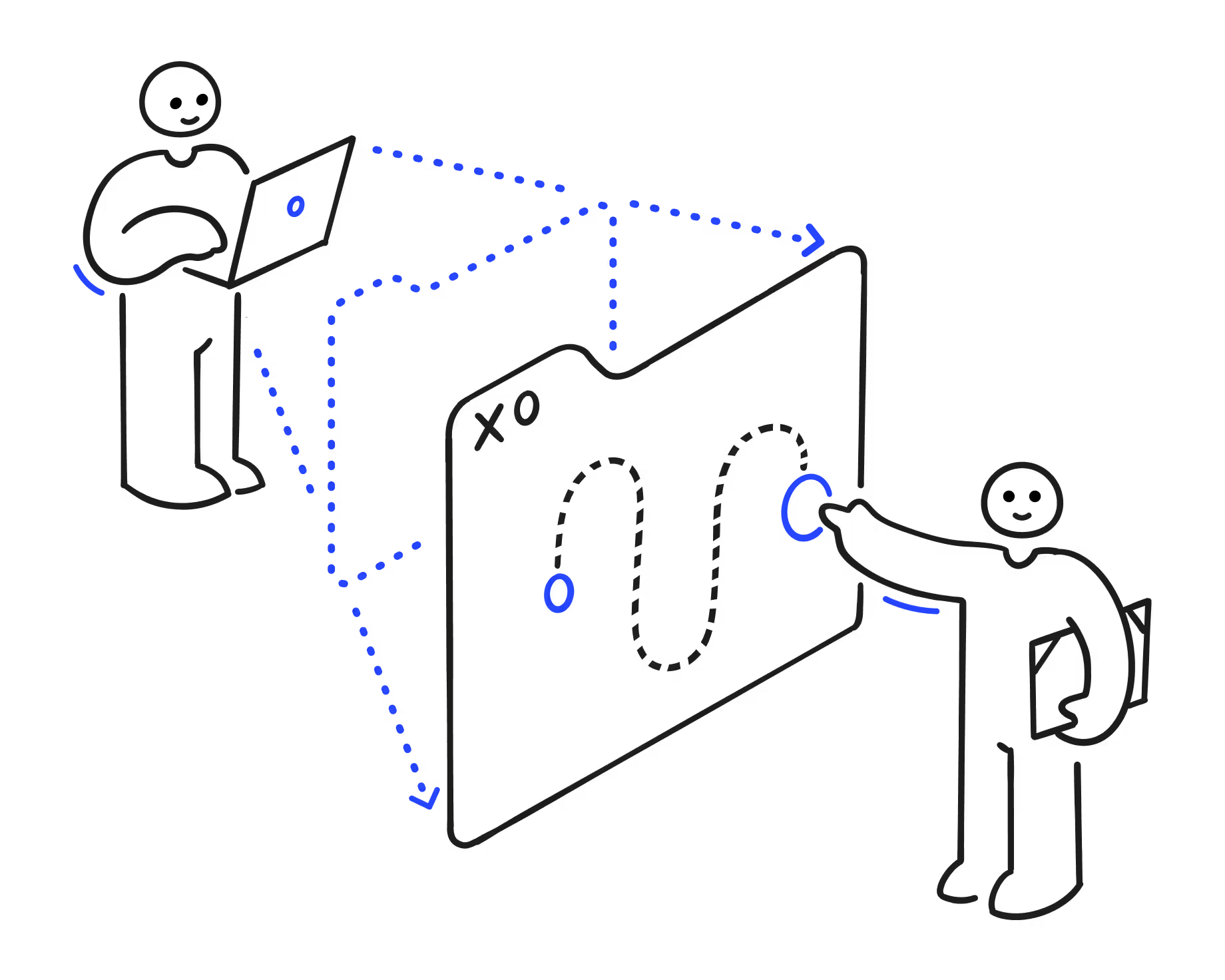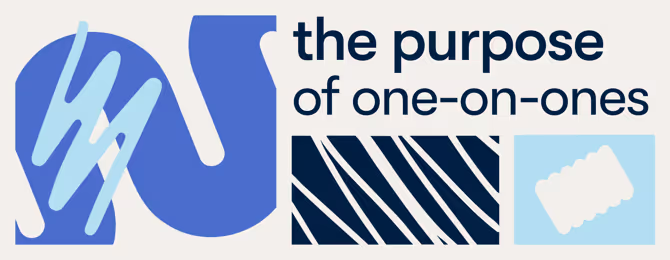How to create a check-in meeting agenda that works

Discover Workleap Officevibe's benchmark report on 12 key employee engagement metrics

Check-in meetings without purpose can easily turn into a drain on time. The conversation drifts, managers talk more than their team members, and people leave confused about the action items.
A strong check-in meeting agenda transforms these meetings from time-wasters to progress-drivers. It provides a shared structure for everyone to follow and keeps status updates from taking up the entire time block. It also creates space for real feedback, better communication, prioritization, and visible progress.
The right agenda turns weekly one-on-ones and team meetings into valuable team alignment time. Here’s how.
What is a check-in meeting?
Check-in meetings are short, structured conversations, usually between a manager and a team member. They are typically held weekly, but can be less frequent. Done right, regular check-ins boost employee engagement: According to Gallup and Workhuman, 61% of employees who receive feedback and recognition report being more engaged at work.
Check-ins also strengthen company culture, spot blockers early, and provide valuable feedback. They’re a great way of showing you’re invested in employees’ progress, while helping catch smaller issues before they grow.
Here are a few of the most important benefits:
- Increase communication and alignment: Regular check-ins help managers and team members prioritize tasks and keep projects on track. This keeps everyone aligned, so no one is guessing about what matters most.
- Connect with your team: More than just a status update, check-ins are a great way to connect with your employees. They’re a time to discuss tasks, priorities, and issues like workplace conflicts.
- Enhance employee engagement: Employees who know there’s a dedicated space for feedback and open conversation feel valued and heard. Consistent one-on-one meetings improve internal communication and employee engagement over time.
- Identify challenges early on: Check-in meetings catch roadblocks before they spiral into bigger problems. Discussing obstacles as they happen allows managers to provide resources or adjust workloads on the fly.
- Provide support and feedback: A structured check-in meeting agenda lets you sync with your team on professional development and growth. It’s an effective way to coach employees while recognizing them for their wins.
- Build stronger relationships: Beyond status updates and action items, check-ins allow you to connect with direct reports on a human level. They build rapport, improve workplace communications, and create a healthy and supportive work environment.
5 types of check-in meetings
Check-ins can take different forms depending on your goals. Here are five of the most common types and what the agendas usually include.
1. One-on-one check-in meetings
One-on-one check-ins are when you connect directly with a team member. These conversations tend to be deeper than just a quick status update. They cover everything from tracking a project’s progress to clearing roadblocks and offering personalized feedback.
2. Team check-in meetings
A team check-in helps get the whole team on the same page. These short meetings boost collaboration by providing updates on what’s happening across different projects. The meeting agenda is usually light, focusing on wins, blockers, and action items, but the impact can be huge.
3. Weekly status updates
This type of check-in takes a quick look at recent progress. This can include what’s been accomplished so far, what’s coming up, and any urgent priorities. When they’re done well, these meetings boost consistency and accountability without eating up too much time.
4. Project-specific check-ins
Sometimes, you need a check-in that focuses on one project. These meetings gather everyone working on a project to share updates, whether that’s reviewing the project timeline or sharing any blockers slowing things down. The check-in meeting agenda usually includes milestones, deliverables, and risks.
5. Onboarding check-ins
Regular check-ins shortly after an employee joins your company offer a warm welcome to the team, which can make all the difference for new hires. These meetings focus on role clarity, early wins, and feedback. A check-in meeting agenda might include training progress, questions about the work environment, and opportunities to build rapport.
Workleap Officevibe strengthens check-in meeting agendas with custom surveys, anonymous feedback, and peer-to-peer recognition. Use the platform’s optional employee check-in templates to guide meaningful conversations with your direct reports.
How to plan a productive team check-in meeting
Follow these four steps to map out a check-in meeting agenda that actually works:
1. Set a steady rhythm
Schedule check-in meetings consistently to help them feel intentional instead of optional. Aim for weekly or bi-weekly meetings where possible. Research shows that regular one-on-one meetings can increase employee engagement, meaning lower turnover and absenteeism and higher productivity.
2. Start with a shared roadmap
Co-create the meeting agenda with team members for better clarity. Lay out sections like progress updates, feedback, action items, and key discussion points. When a meeting agenda reflects attendees’ priorities, the conversation stays relevant, keeping employees invested.
3. Take time to prepare
Scan your recent project and meeting notes and consider what’s changed between check-ins. Ask your report to do the same by thinking about their recent wins, pain points, and any burning questions. When you’re both prepared, you jump right into meaningful conversation.
4. Pick the best space for connection
Choose the right setting for the check-in. If you’re in the office, find a quiet spot or conference room to avoid distractions. If you’re remote, keep things personal with a video chat platform.
Weekly check-ins: How to create a focused agenda
A strong check-in meeting agenda keeps conversations productive and ensures team members leave with clarity. Here’s how to build a manager check-in template that works:
- Start with introductions: If there are new faces in the room, set the tone with a quick round of friendly introductions. It builds rapport and creates a space where everyone feels welcome and like they can contribute.
- Recap the last meeting: Review the outstanding action items and key takeaways from the previous check-in meeting. This quick overview holds workers accountable and starts the conversation on a forward note.
- Discuss the current projects and progress: This is the focal point of most weekly check-ins. Discuss ongoing tasks, milestones, and roadblocks, focusing updates on top-priority issues.
- Identify any challenges: Invite employees to bring up any issues they’re facing and brainstorm how to fix them together. This might mean shifting resources or providing extra support so progress doesn’t stall.
- Share feedback and recognition: Dedicate a few minutes to feedback. Recognize your team member’s wins, reinforce their strengths, and offer guidance if and when it’s needed. Recognition is powerful and fuels employee engagement.
- Touch on performance (if needed): Occasional performance touchpoints help managers and direct reports align on growth and expectations. But not every check-in requires an evaluation, so only do so when necessary.
- Set goals for the future: Define any upcoming project deadlines and confirm what success looks like to motivate your employees. Let your team know what their next steps are and ask them if they have any questions.
- Open discussion and take questions: Reserve time for open conversation. Encourage employees to ask questions, raise concerns, and pitch new ideas. This two-way conversation helps workers feel heard.
- Capture key takeaways: Wrap up the meeting by summarizing items, decisions, and next steps. Take notes so you’re prepared for the next weekly check-in.
Sample manager’s check-in template
We’ve put together a simple example check-in meeting agenda to help you get started. This sample outline keeps things focused, flexible, and adaptable. It can be adapted to different meeting cadences and types, such as simple project updates or detailed one-on-ones.
- Welcome and introductions (2-3 minutes)
- Review the previous meeting’s action items (5 minutes)
- Current projects and progress updates (10-15 minutes)
- Challenges and roadblocks (5-10 minutes)
- Feedback and recognition (5 minutes)
- Performance review (if needed, 5 minutes)
- Set goals and define next action items (10 minutes)
- Open discussion and Q&A (5 minutes)
- Confirm takeaways and details for the next meeting (2-3 minutes)
Take your check-ins further with Workleap
When guided by a clear meeting agenda, check-in meetings are a powerful way to keep a team aligned, engaged, and moving forward. Regular, consistent conversations build trust and celebrate progress, even when brief. They also identify challenges or roadblocks before they snowball.
With Workleap Officevibe, you can make the most of your check-ins. Run anonymous pulse surveys and collect feedback about your team’s experience, and use peer recognition tools to give managers the insight they need to support their people. One-on-one meeting templates are also available to help you make your check-ins more structured and meaningful.
Try Workleap for free today, or request a demo.
Give HR and managers the clarity, confidence, and connection to lead better every day.


%20(1).avif)


.avif)
.avif)








